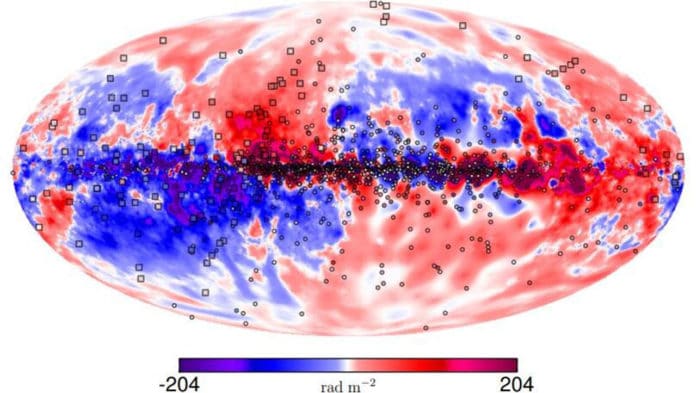Mapping our galaxy's magnetic field
Expanding our knowledge of the Milky Way's 3-D structure.
BY
AMIT MALEWAR
DECEMBER 1, 2019
 A representation of how our Galaxy would look in the sky if we could see magnetic fields. The plane of the Galaxy runs horizontally through the middle, and the Galactic centre direction is the middle of the map. Red–pink colours show increasing Galactic magnetic field strengths where the direction is pointing towards the Earth. Blue–purple colours show increasing Galactic magnetic field strengths where the direction is pointing away from the Earth. The background shows the signal reconstructed using sources outside our Galaxy. The points show the current measurements for pulsars. The squares show the measurements from this work using LOFAR pulsar observations. Credit: Freshscience
A representation of how our Galaxy would look in the sky if we could see magnetic fields. The plane of the Galaxy runs horizontally through the middle, and the Galactic centre direction is the middle of the map. Red–pink colours show increasing Galactic magnetic field strengths where the direction is pointing towards the Earth. Blue–purple colours show increasing Galactic magnetic field strengths where the direction is pointing away from the Earth. The background shows the signal reconstructed using sources outside our Galaxy. The points show the current measurements for pulsars. The squares show the measurements from this work using LOFAR pulsar observations. Credit: Freshscience
In collaboration with colleagues from Europe, Canada, and South Africa, Astronomers from CSIRO and Curtin University, used pulsars to probe the Milky Way’s magnetic field. They have published the most precise catalog of measurements towards mapping our Galaxy’s magnetic field in 3-D.
They used pulsars to probe the Galaxy’s magnetic field in 3-D effectively. Pulsars are distributed all through the Milky Way, and the intervening material in the Galaxy affects their radio-wave emission.
Using a large European radio telescope called LOFAR, scientists assembled the most extensive low-frequency catalog of magnetic field strengths and directions towards pulsars, to date. The outcomes estimated how the Galactic magnetic field strength decreases with distance from the plane of the Galaxy.
Dr. Charlotte Sobey, the lead author of the research paper, said, “This is an indication of the great results that we can achieve using the next-generation of radio telescopes. Since we cannot observe our entire Galaxy from one place on Earth, we are now using the MWA (Murchison Widefield Array) in Western Australia to observe pulsars in the southern sky.”
https://www.techexplorist.com/mapping-galaxy-magnetic-field/28091/?utm_source=BN&utm_medium=BN&utm_campaign=BN&utm_term=BN&utm_content=BN
